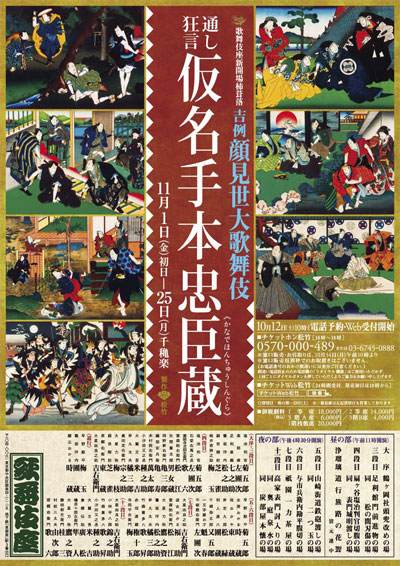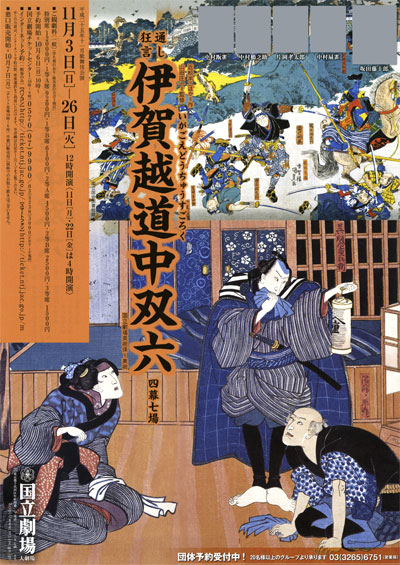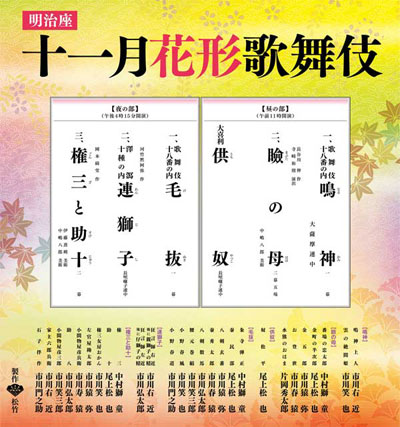| NOVEMBER 2013 |
|
5 shows in T˘ky˘ (Kabukiza, National Theatre, Meijiza), 1 in Toyooka (Eirakukan), 1 tour (Sh˘chiku ďkabuki Tour) and 2 on Shikoku island (Kanamaruza)!
|
| Kabukiza (T˘ky˘) |  |
| Dates | 1 ~ 25 November 2013 (Kokera Otoshi Kichirei Kaomise ďkabuki) Opening Ceremony Annual Festive Face-Showing Grand Kabuki |
| MatinÚe |
|
| Evening |
|
| Casting |
Onoe Kikugor˘, Nakamura Kichiemon, Nakamura Baigyoku, Nakamura Tokiz˘, Nakamura Shibajaku, Nakamura Fukusuke, Nakamura Kaishun, Nakamura Shichinosuke, Onoe Sh˘roku, Ichikawa Danz˘, Nakamura Kinnosuke, Ichikawa Sadanji, Nakamura T˘z˘, Nakamura Karoku, Nakamura Matagor˘ |
| Comments |
8th month celebrating the opening of the new Kabukiza within a 1-year long cycle of kokera otoshi programs. The play "Kanadehon Chűshingura" (The Treasure of 47 Loyal Retainers) is the most popular in the Kabuki repertory and is known throughout the world.
|
 |
| National Theatre (T˘ky˘) |
| Dates | 3 ~ 26 November 2013 |
| Program |
|
| Casting |
Sakata T˘jűr˘, Nakamura Kanjaku, Nakamura Hashinosuke, Nakamura Senjaku, Kataoka Takatar˘, Kataoka Ichiz˘, Band˘ Hikosabur˘, Ichimura Manjir˘, Kataoka Kamez˘, Ichimura Kakitsu, Nakamura Kikaku, Nakamura Toranosuke |
| Comments |
Revival at the National Theatre in 4 acts and 7 scenes of Chikamatsu Hanji's drama "Igagoe D˘chű Sugoroku".
|
 |
| Meijiza (T˘ky˘) |  |
| Dates | 1 ~ 25 November 2013 (Jűichigatsu Hanagata Kabuki) November Young Actors Kabuki |
| MatinÚe | |
| Evening | |
| Casting |
Kataoka Hidetar˘, Nakamura Shid˘, Onoe Matsuya, Ichikawa Ukon, Ichikawa Monnosuke, Ichikawa Juen, Ichikawa Emiya, Ichikawa Emisabur˘, Ichikawa En'ya, Ichikawa Shun'en, Ichikawa K˘tar˘ |
| Comments |
|
 |
| Eirakukan (Toyooka) |  |
| Dates | 5 ~ 10 November 2013 (Eirakukan ďkabuki) |
| Program |
Garasha |
| Casting |
Kataoka Ainosuke, Kamimura Kichiya, Band˘ Shinsha, Nakamura Kazutar˘ |
| Comments |
This is the 6th Kabuki program at the Eirakukan, a renovated traditional theater built in the city of Toyooka (prefecture of Hy˘go).
|
 |
| Sh˘chiku ďkabuki Tour | |
| Dates | 1 ~ 25 November 2012 (Sh˘chiku ďkabuki) Sh˘chiku Grand Kabuki |
| Program | |
| Casting |
Onoe Kikunosuke, Band˘ Yajűr˘, Band˘ Shűch˘, Band˘ Minosuke, Onoe Ukon |
| Comments |
A special Autumn tour sponsored by the Sh˘chiku!
|
| Kanamaruza (Konpira) |
| Dates | 31 October ~ 10 November 2013 (Band˘ Tamasabur˘ Tokubetsu K˘en) Band˘ Tamasabur˘ Special Performances |
| 1st Program |
Kosunoto Yukari no Tsuki |
| 2nd Program |
Amaterasu |
| Casting | |
| Comments |
Living National Treasure Band˘ Tamasabur˘ and the Kod˘ taiko drummers revive "Amaterasu", which was staged for the first time in May 2006 at the Minamiza [more details]. |
|
|
| Contact | Main | Top | Updates | Actors | Plays | Playwrights | Programs | Links | FAQ | Glossary | Chronology | Illustrations | Prints | Characters | Derivatives | Theaters | Coming soon | News |